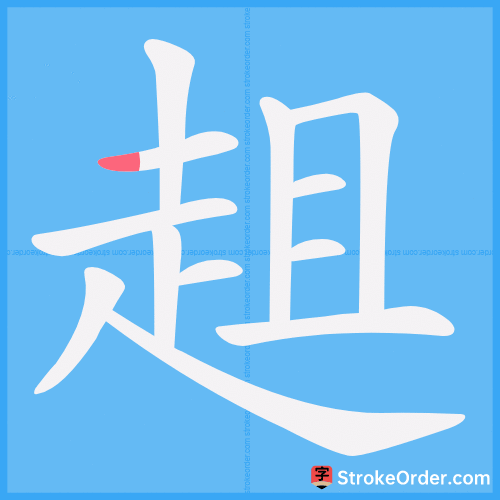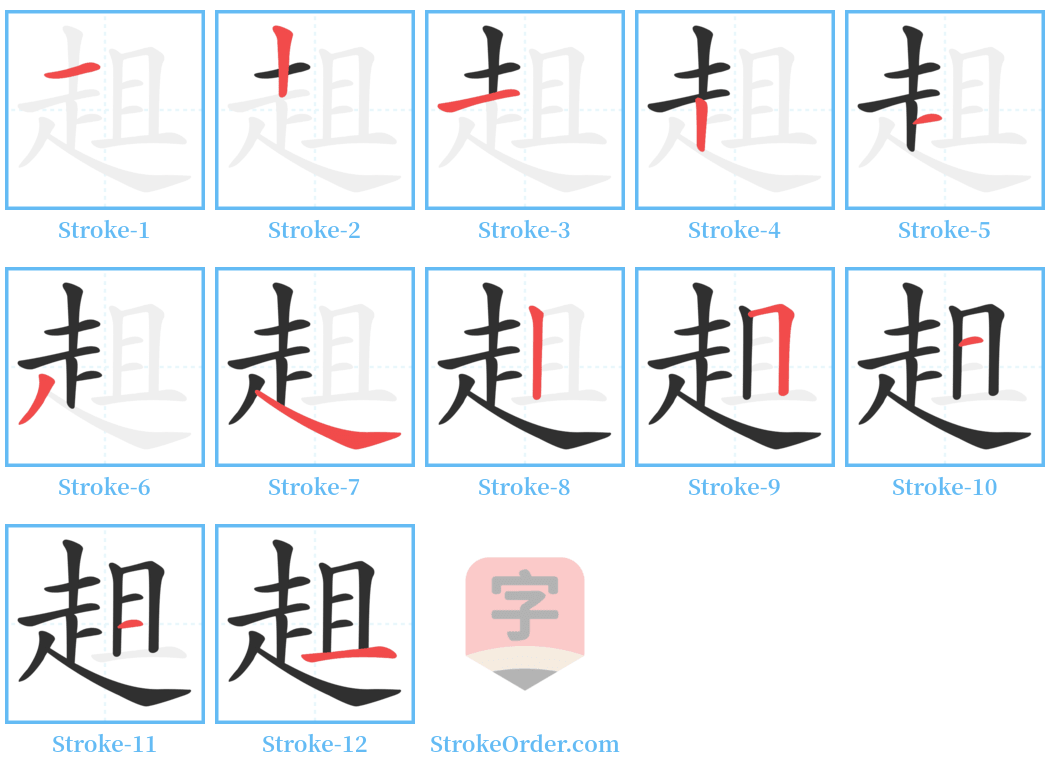趄 Stroke Order
Animated Stroke Order of 趄

Stroke Order Diagrams for 趄

Step-by-Step Handwriting Guide for 趄

Learn to Write Chinese Characters with Video Tutorials
Watch the video of writing the Chinese character "趄", learn the correct stroke order (笔顺) of the character "趄", and master the standard way of writing the character "趄".
Free Printable Handwriting Practice with Stroke Order: 趄
Printable Writing Practice Worksheet of "趄" in Portrait Orientation (Tian Zi Ge)

Printable Writing Practice Worksheet of "趄" in Landscape Orientation (Tian Zi Ge)

Information of 趄
Pinyin
qiè、 jū
Radical
走
Strokes
12 strokes
Usage
★★★★
Definition
hesitate / mark time, recline
趄 [qiè]
1. (see 趔)
2. Inclined; slanting: ~ slope; ~ing one's body.
趄 [qiè]
1. Inclined; slanting ([En.] inclined; slanting).
2. (Regional) Sticking up ([En.] stick up).
3. Leaning to one side; inclined ([En.] recline).
4. See also jū; qiè.
趄 [qiè]
1. Inclined; slanting ([En.] inclined; slanting).
【Reference】
1. "Water Margin": Song Jiang had already had eight parts of wine, and his steps became unsteady, just stepping forward.
【Example】
For example: 趄趄 (to walk sideways, in a respectful manner); 趄趄趔趔 (the manner of walking unsteadily).
2. (Regional) Sticking up ([En.] stick up).
【Reference】
1. Xu Jiarui's "A Study on Dialects in Yuan Drama": 趄 means to stick up. In Kunming dialect, it refers to sticking one's buttocks up.
3. Leaning to one side; inclined ([En.] recline).
【Reference】
1. Yuan Dynasty, Wang Shifu's "The Story of the Western Chamber": The banquet was noisy; it was not known that the beauty was leaning down.
【Example】
For example: 趄着身子 (leaning the body).
趄 [jū]
1. Hesitant; the look of not being able to move forward ([En.] hesitate).
2. To separate ([En.] separate).
3. See also qiè; qiè.
趄 [jū]
1. Hesitant; the look of not being able to move forward ([En.] hesitate).
【Example】
For instance: 趄避 (to skillfully avoid); 趄趄 (looking like wanting to walk but then retreating); 趄趄趔趔 (the manner of walking unsteadily).
2. To separate ([En.] separate).
【Reference】
1. "Principles of Architectural Construction": The top of the box is covered with fine dust; it has a sunken top and is tied at the four corners.
3. See also qiè; qiè.
趄 [qie]
1. (see 趔趄)
2. See also jū; qiè.
趄 [qie]
1. (see 趔趄)
2. See also jū; qiè.
Input Method for 趄
Pinyin
qie4
Wubi
fheg
Cangjie
gobm
Zhengma
bolc
Four Corner
47801
Unicode
U+8d84
Same Pronunciation Characters